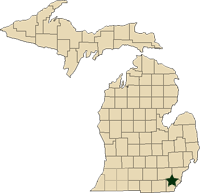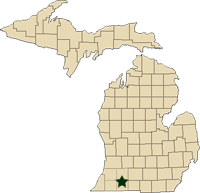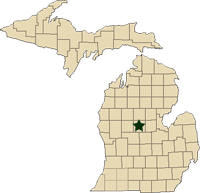Regional reports on Michigan field crops – August 11, 2011
MSU Extension educators’ pest and field crop updates for Michigan.
This week’s regional reports:
- Southeast Michigan – Ned Birkey
- Southwest Michigan – Bruce Mackellar
- Central Michigan – Paul Gross
Southeast Michigan – Ned Birkey, Michigan State University Extension
|
Weather has changed to more seasonal temperatures and increased rainfall, fog and dew. Southeast Michigan has had 4 to 12-plus inches of rain over the past two weeks. The northern part of this area had much more rain, with some ditch banks collapsing due to flash flooding. The tiles are running there, while drainage tiles are not running in the southern part. Last night (August 10) the low temperature was in the 50s for the first time since mid-June.
Alfalfa growth is recovering with the recent rainfall. A third cutting will depend upon the forecast. Potato leafhoppers remain the main insect pest and cause severe yellowing, which stunts growth and affects yield and quality.
Corn is at variable growth stages, with advanced fields finished pollination and late fields approaching tasseling. The delay in growth and development means that the extreme heat may have come too soon to prevent pollination and kernel set in many fields. Farmers will be able to examine ears in the next couple of weeks to see if ears will have a normal amount of kernels. Western bean cutworm trap counts have dropped dramatically this week, going from 36 to 2 in Monroe County and 26 to 7 in Washtenaw County. European corn borer and corn earworm numbers have risen slightly, though numbers are still extremely low.
Soybeans are at the R3 to R4 pod stage. Japanese beetles are the predominant leaf feeders, with grasshoppers and bean leaf beetles also present. In no cases have I found a field with such severe leaf feeding and defoliation to warrant an insecticide treatment. Although one or a few leaves may be severely eaten, the vast majority of leaves are intact and provide plenty of surface for photosynthesis. Yellow sticky traps in three counties had only one variant western corn rootworm. The only year that this trapping project was over threshold with this particular insect was in 2000 and then only in one of 10 locations being trapped in Monroe and Lenawee counties. I have not seen soybean aphids in my trapping locations, though last night at the Wayne County Fair 4-H auction, Ida Coop reported that one farmer has found low numbers of aphids. We got the last foliar fertilizer spray plot applied last week in Monroe and are waiting for the soybean field to dry out to apply this treatment in Washtenaw County.
Fall field crop Extension field days for southeast Michigan
August 31, SDS/SCN Treatments at the Matt Schultz Farm
South Toledo Street, Dundee, Mich. 5:00 to 8:00 p.m.
This is the first location that I found SDS in southeast Michigan back in the late 1990s.
September 6, Corn and Soybean Plots at the Jerry Kuhl Farm
Peckins Road, Chelsea, Mich., 4:00 to 7:00 p.m.
Plots include corn trait plot, corn planting rate plot, soybean planting rate plot, soybean foliar fertilizer with both Conklin and Wilbur Ellis products. The new MSU/MSPC developed soybean aphid resistant soybeans will be showcased.
September 7, Soybean Plots at the Herb Smith/Alan Matthes Farms
5634 Dunbar Road, Ida, Mich., 4:00 to 7:00 p.m.
Plots include soybean planting rate plot, soybean foliar fertilizer plots with both the Conklin and Wilbur Ellis products and the new MSU/MSPC developed soybean aphid resistant soybeans will be showcased.
All field days are free and open to any interested corn or soybean farmer. No registration is required. No pesticide credits will be offered. A free porkburger supper will be provided.
View the insect trap results so far this year.
Southwest Michigan – Bruce Mackellar, Michigan State University Extension
|
Weather
Recent passage of a series of cold fronts has thankfully turned the thermostat down in southwest Michigan. Cooler temperatures and comfortable humidity levels are expected for the next several days and nights, providing respite for those tired of sweating every time they do anything outside. Rainfall has been somewhat less prevalent over the last week in some parts of the southwest region. We have, however, generally been able to keep pace with crop water demands with thunderstorm rainfall that has been more in the normal expectations rather than the heavy downpours we experienced during the previous weeks.
Temperatures
A quick look around the region shows that we are at 1729 to 1920 GDD’s Base 50 since May 1, depending upon the proximity to Lake Michigan, with an average of 1850 for the 12 Enviro-weather stations in the southwestern portion of the region. This has moved us above the long term average GDD accumulation in the region of 1710 (about five to six hot summer days). The average GDD accumulation Base 50 in the region for the next five days is 19.4, and the following five days is 19.0.
The 6-10 day and 8-14 day outlooks predict an end to the comfortable weather, and have southwest Michigan solidly in the above normal temperature zone. In looking at one area where planting was significantly delayed because of the wet spring (southern Berrien County), the GDD totals since June 15 have been around 1300 Base 50. The warmer-than-normal temperatures have really helped the corn crop to develop quickly, despite the planting delays.
Rainfall
Rainfall totals since July 28 range between 1.62 inches in Watervliet, Mich., and 4.17 inches in South Haven, Mich. The average precipitation total for the 12 Enviro-weather stations during this period was 2.63 inches. Both the 6-10 day and 8-14 day outlooks have southwest Michigan in the normal precipitation range. However, the below normal area extends fairly close to the Michigan/Indiana border.
Crops
The alfalfa report has pretty much been the same most of the season. We have had decent harvest windows, but there also have been times when showers and humidity have made harvest nearly impossible. Hay quality often depended on the value of the weather forecast when it was cut. Potato leafhopper numbers remain high. We are just about to reach the point in the season when pathogenic fungi are capable of rapidly reducing their numbers. Wet mornings where fog is common until 11:00 a.m. often help these infections to get underway. Remember, alfalfa regrowth thresholds for treatment are pretty low, two potato leafhoppers per sweep, 1- to 3- inch alfalfa. Even on more mature alfalfa, it is important to watch for signs of leafhopper feeding injury.
My reference corn fields that were planted in mid-June have completed pollination and are moving into the blister stage. Early planted corn is progressing rapidly. The warm conditions have greatly benefited the growth of the later planted corn. Western bean cutworm moth flight has been on the decline. We continue to catch a few moths in Van Buren County, but numbers have dropped off significantly over the last two weeks. We will begin assessing damage in the next couple of weeks.
We have had a couple of fields impacted by gray leaf spot in corn fields. The disease has primarily been on susceptible varieties in low air flow areas of the fields. Incidence of other leaf diseases has been light so far in most fields I have walked. Drought stress during the rapid elongation phase of corn development may have taken a few bushels per acre off the top of corn planted in the early May window, even in the southwest region, where moisture has been generally pretty good. Kernel set during pollination generally looks pretty good, although some ear tips may not fully fill. Some fields have shown husk separation exposing ear tips to desiccation.
Male row destruction is on-going in seed corn. Pollination has looked pretty typical in spite of the warm temperatures in the few fields that I have walked. Continue to monitor for corn leaf diseases, particularly gray leaf spot in seed fields. Watch for corn earworm activity, particularly in later planted fields.
Most soybean fields are heading into pod fill, R4-early R5. The very earliest soybeans in our sudden death syndrome trial are beginning to reach maturity. The plants generally have a very dense canopy. Soybean aphids are still prevalent in the western portions of the region. I have generally not seen elevated aphid numbers east of western St. Joseph County. Several fields have been sprayed in points west. Aphid numbers remain higher, but below where I would expect damage in later R4 beans or beyond. We hopefully will see an increase in the incidence of pathogenic fungi.
A return to hot and dry conditions may warrant closer evaluation for both soybean aphids and spider mite activity. Spider mites often get a foothold in dry and dusty areas in fields. Wet and humid conditions usually provide a boost to pathogenic fungi, which can crash populations of spider mites and soybean aphids quickly. Continue to be on the lookout for white mold development. We have seen white mold in some irrigated fields in southwest Michigan. We also are beginning to see evidence of sudden death syndrome in several irrigated fields in southwest Michigan. For more on sudden death syndrome, read What to look for when scouting for sudden death syndrome in soybean fields.
Soybean Disease Center Field Day
Come join us August 24 in Decatur, Mich., to learn about sudden death syndrome, white mold, soybean aphids and glyphosate resistant palmer amaranth. Don’t miss this opportunity to learn about sudden death syndrome and palmer amaranth before they are a problem on your farm. The program will run from 9:00 a.m. to noon and will feature several stops around the field research site. The site features an MSU soybean variety trial, so you can see how your favorite soybean varieties in this high sudden death syndrome pressure field. An excellent steak lunch will be provided at noon by Scotts Pig Roast and More from Marcellus, Mich. RUP and CCA credits will be available. The program is sponsored by the Michigan Soybean Promotion Committee, and registration and the meal are free of charge. For registration and location information, please call the Van Buren County MSU Extension office at 269-657-8213.
Central Michigan – Paul Gross, Michigan State University Extension
|
Weather
Rain and cooler temperatures over the past week are providing good conditions for pollination in corn. Rainfall totals varied across the region with the southern portion receiving about 8 inches. The rains have replenished soil moisture at this time. The region is just ahead of normal for growing degree days. We will need normal to above normal temperatures to mature a late planted crop.
Commodity reports
The corn crop is progressing nicely with adequate rainfall and moderate temperatures. Much of the late planted crop is catching up, but will still need a long fall to mature and dry to acceptable moisture. The western bean cutworm trap catches have continued to decline. There have been reports of corn rootworm adults feeding on silks in some areas. Continue to scout fields for disease and insect problems. The temperatures are cooler, so now is a good time to walk the field to assess your stands, dig some roots and look for problem spots in your fields.
Soybeans are in R3 to R4 and benefiting from the recent rains. The yield potential looks favorable at this time. It has been observed that pod set in the early planted fields may have been hurt by the excessive heat. Field activities include some herbicide, insecticide and fungicide applications. There are soybean aphids in most fields, but below thresholds. Continue to scout fields for insect and disease problems.
Harvest of third cutting alfalfa is progressing between rains. Yields have been good. Potato leafhopper populations are very high. Scout regrowth for this pest and take appropriate steps to manage this pest.
Oat and barley harvest is progressing as weather allows. Yields are being reported as disappointing. Excessive heat during grain fill may have contributed to the lower yields.
This year’s wheat crop is being described as very good. It will be important to manage weeds and volunteer wheat in these fields. Growers may want to consider planting a cover crop to protect these fields and prepare them for next year’s crop. Visit the Midwest Cover Crops Council website to assist in selecting a cover crop that would be best suited for your needs.
The dry bean crop is progressing rapidly. Many fields have filled the rows and beginning to set pods. There is some concern with white mold and western bean cutworm. Scout fields to determine pest problems. This year, decisions to manage western bean cutworm should be done on a field-by-field basis.



 Print
Print Email
Email







